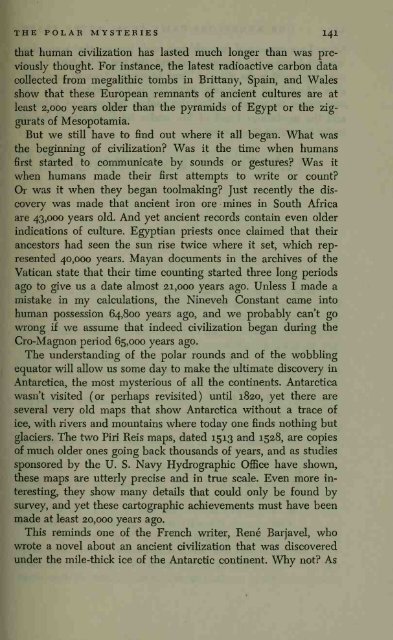You also want an ePaper? Increase the reach of your titles
YUMPU automatically turns print PDFs into web optimized ePapers that Google loves.
THE POLAR MYSTERIES<br />
I4I<br />
that human civilization has lasted much longer than was previously<br />
thought. For instance, the latest radioactive carbon data<br />
collected from megaHthic tombs in Brittany, Spain, and Wales<br />
show that these European remnants of ancient cultures are at<br />
least 2,000 years older than the pyramids of Egypt or the ziggurats<br />
of Mesopotamia.<br />
But we still have to find out where it all began. What was<br />
the beginning of civilization? Was it the time when humans<br />
first started to communicate by sounds or gestures? Was it<br />
when humans made their first attempts to write or count?<br />
Or was it when they began toolmaking? Just recently the discovery<br />
was made that ancient iron ore mines in South Africa<br />
are 43,000 years old. And yet ancient records contain even older<br />
indications of culture. Egyptian priests once claimed that their<br />
ancestors had seen the sun rise twice where it set, which represented<br />
40,000 years. Mayan documents in the archives of the<br />
Vatican state that their time counting started three long periods<br />
ago to give us a date almost 21,000 years ago. Unless I<br />
made a<br />
mistake in my calculations, the Nineveh Constant came into<br />
human possession 64,800 years ago, and we probably can't go<br />
wrong if we assume that indeed civilization began during the<br />
Cro-Magnon period 65,000 years ago.<br />
The understanding of the polar rounds and of the wobbling<br />
equator will allow us some day to make the ultimate discovery in<br />
Antarctica, the most mysterious of all the continents. Antarctica<br />
wasn't visited (or perhaps revisited) until 1820, yet there are<br />
several very old maps that show Antarctica without a trace of<br />
ice, with rivers and mountains where today one finds nothing but<br />
glaciers. The two Piri Reis maps, dated 1513 and 1528, are copies<br />
of much older ones going back thousands of years, and as studies<br />
sponsored by the U. S. Navy Hydrographic OflSce have shown,<br />
these maps are utterly precise and in true scale. Even more interesting,<br />
they show many details that could only be found by<br />
survey, and yet these cartographic achievements must have been<br />
made at least 20,000 years ago.<br />
This reminds one of the French writer, Rene Barjavel, who<br />
wrote a novel about an ancient civilization that was discovered<br />
under the mile-thick ice of the Antarctic continent. Why not? As

















